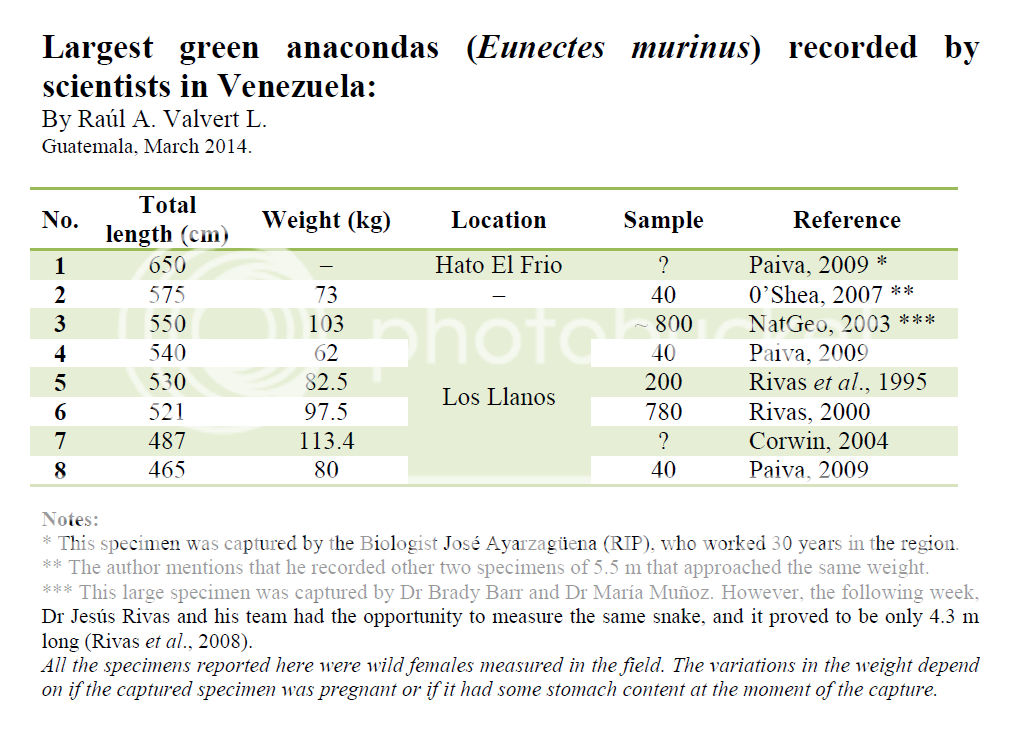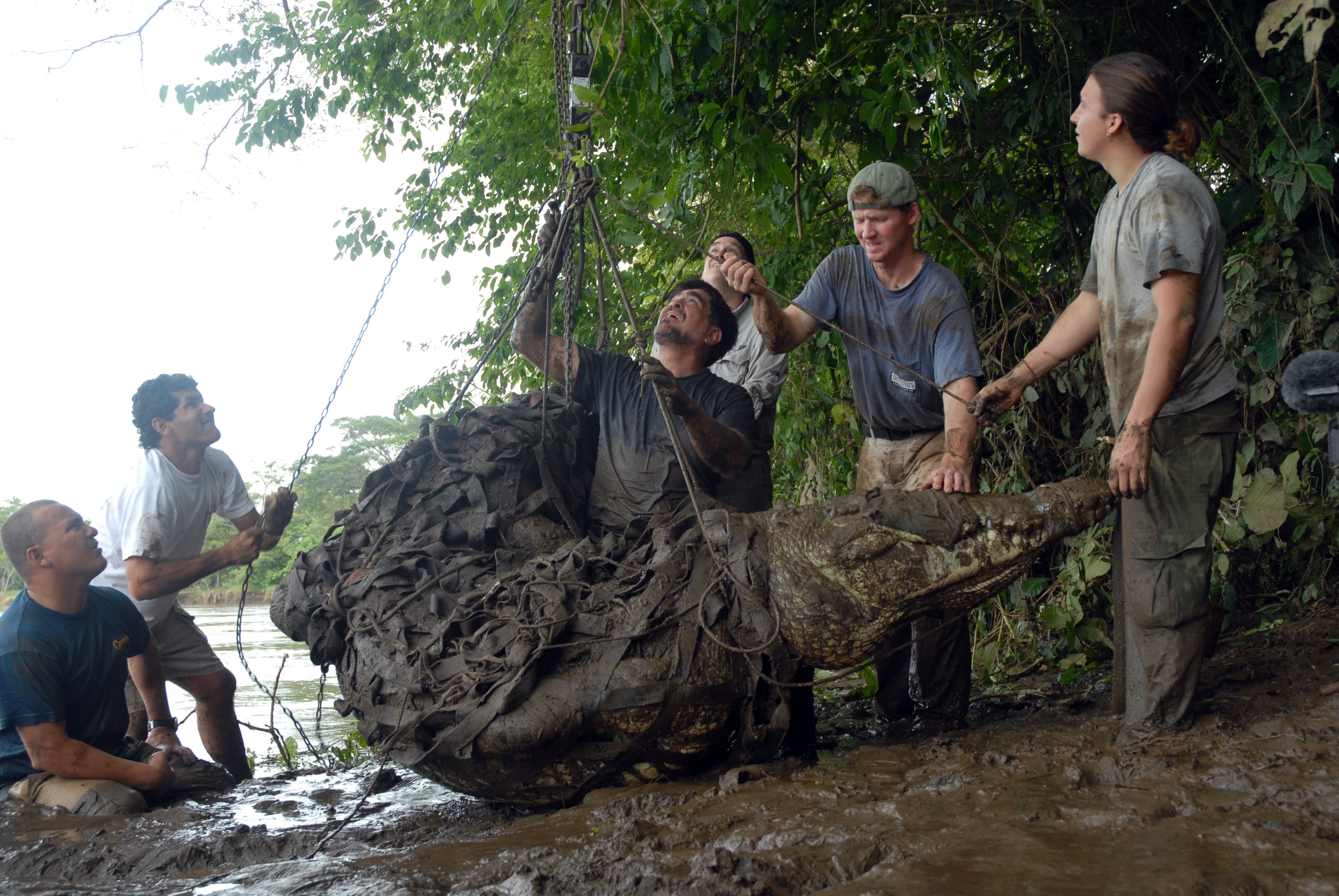guategojira
Junior Member
  Now I become death, the destroyer of worlds!
Now I become death, the destroyer of worlds!
Posts: 160 
|
Post by guategojira on Mar 27, 2014 12:52:14 GMT 5
Thanks man. Guate, as a matter of fact, you can copy my table if you want and complete the footnotes. I will probably not be able to get to it today, but I'll try to finish it ASAP.  Here is my new table (2014) about the largest anacondas captured by scientists in Venezuela (and apparently in all South America).  This is an example of how you could prepare your table about the length of large crocodiles. Take your time, believe me, if you want a good work, you must do it slowly and make it many reviews (from you and others, if possible) before its final publication. I think that, if you use a wise time, your table will be finished by the next Monday.  Greetings and cheers.  |
|
guategojira
Junior Member
  Now I become death, the destroyer of worlds!
Now I become death, the destroyer of worlds!
Posts: 160 
|
Post by guategojira on Apr 1, 2014 2:16:17 GMT 5
The American GIANT!!! I finally found the record, from Dr Brady Barr himself. Here is the link for the full story: bradybarr.com/2008/07/29/a-really-big-problem/It seems that I made a "heavy" mistake. The large American crocodile do measured 16 ft (488 cm), but take in count that the tip of the tail was missing, so I believe that this animal is a perfect candidate for a 5 m giant! The thing is that this giant don't weighed 490 kg, nor even 500 kg, the TRUE weight of this monster was of 1,600 LB!!!! (725.7 kg). It is a REAL worldwide record, fully reliable and even taped on video.  Here is the picture of this giant been weighed:  I will try to found the video in Youtube, but for the moment, you can quote the source of this big croc like (Barr, 2008) as it is from his own communication. Here is more data about the location of this capture: insidecostarica.com/dailynews/2008/june/08/nac05.htmI am very existed about this. Now, I will also try to found a record anaconda that he captured in Venezuela that measured 5.5 m and weighed 103 kg, larger than the largest specimen captured by Dr Jesús Rivas.  Guys, I manage to recover the video of the capture of this giant crocodile and guess what? The weight is NOT 1,600 lb., but 1,250 lb. (567 kg)!!! Check the images: * Original * Enhanced: * Enhanced: The real figure of the scale was of 1,250 lb., but taking in count that the weight of the net and ropes most be subtracted, the real weight of the animal itself was of 540 kg (1,190.5 kg). This is WAY different than the figure of 1,600 lb posted in the blog. This is a clear example of how exaggerations born in literature. By the way, the real length of the crocodile was of exactly 482 cm (15.8 ft), but as the tail tip is cut, they guess that the total length was probably of c.500 cm. The tail girth was of 57 inches (145 cm) at the base. So, the size of this giant wild crocodile of Costa Rica, probably the largest accurately measured in all America (apart from the American alligators from USA), was of 482 cm in total length, tail girth of 145 cm and a net weight of 540 kg (1,190.5 lb). I hope you take in count this correction for future posts. Greetings.  |
|
pckts
Junior Member
 
Posts: 158 
|
Post by pckts on Apr 3, 2014 1:51:09 GMT 5
Where did you get the weight and length for gustave?
He was never captured.
|
|
|
|
Post by Vodmeister on Apr 3, 2014 2:17:31 GMT 5
Where did you get the weight and length for gustave? He was never captured. Estimate based on most sources. |
|
|
|
Post by Grey on Apr 3, 2014 2:21:47 GMT 5
No one has been talking about Gustave here.
|
|
pckts
Junior Member
 
Posts: 158 
|
Post by pckts on Apr 3, 2014 2:24:28 GMT 5
He is the most unreliable croc to use. Just because his legend has grown to large. People throw out these crazy estimations and claims for him. "he kills adult hippos" "he is 30' long" etc....
I would assume that he is amongst the maximum size, but who knows for sure.
He definitely is no Lolong, that is for sure. IMO
|
|
pckts
Junior Member
 
Posts: 158 
|
Post by pckts on Apr 3, 2014 2:25:10 GMT 5
No one has been talking about Gustave here. He gave a weight and length for Gustave on one of the tables used here. That is why we are discussing it. |
|
|
|
Post by Vodmeister on Apr 3, 2014 2:54:40 GMT 5
30' long is absurd, but 20' long is not unreasonable for Gustave. Also, Lolong is somewhat skinny when compared to Yai and other crocodiles. Gustave also has a great amount of bulk when moving around. Lolong is quite lean.
EDIT: Proportionally speaking, if Gustave was 6.00 m (equal to Yai) in length, he would be 988 kg. Yai is 1,114 kg.
|
|
guategojira
Junior Member
  Now I become death, the destroyer of worlds!
Now I become death, the destroyer of worlds!
Posts: 160 
|
Post by guategojira on Apr 3, 2014 5:47:49 GMT 5
I made a little chart on historically large crocodilians. I objectively defined "large" as any crocodile specimen which is 18 feet or longer, and 900 kg or heavier.  Although I haven't done any research on the American crocodile yet, I wouldn't be surprised if they too had a few >18 ft 900 kg specimens in the past. Pckts, I think you are talking of this table. Next time, quote it, it helps in the discussion. I am agree with you, together with Dr Romulus Whitaker and Dr Adam Briton. They also don't believe in the estimated size of Gustave, to be sincere, there is not a single evidence of that, just a large group of fans with a lot of claims.  However, we most be fair, and in the same case, the reported Guinness record from Bhitarkanika is also unreliable. They estimated the size by unknown means, Dr Briton believe that maybe it was based in the length of the little boat used for locate the animal. Even then, the method is unreliable.  Other problem is that Vod included captive specimens in his table, which create confusion for the new posters. However, he is working in a new corrected table, we most wait for that one.  Finally, I believe that the record of 6.6 m for the Orinoco is probably unreliable to. Pope (1956) quoted a length of 23 ft (701 cm) for two males, one an American Crocodile and another from the Orinoco region. However, Pope is the same person that also believed in anacondas of 9-10 m (check the post of the anacondas, none of those reports is reliable), so I can say with 100% confidence that these lengths are unreliable and based in any real evidence. At the moment, as far I know, the largest crocodile measured in America was the huge male captured and weights by Dr Brady Barr in Costa Rica. Maybe in the past, some giants of 7-8 m could existed in among the Salt-water crocodiles, about 6-7 m in the Nile and 5-6 m in American ones, but now, at 2014, with the heavy over-hunt that crocodiles had suffered, we will be very very very lucky if we found a wild male of 6 m, like was the case of Lolong. Am I too extreme in my conclusions? Possible. Am I too conservative? Totally. But I am tired of the "Godzillification" effect in modern and prehistoric animals. |
|
guategojira
Junior Member
  Now I become death, the destroyer of worlds!
Now I become death, the destroyer of worlds!
Posts: 160 
|
Post by guategojira on Apr 3, 2014 5:55:23 GMT 5
30' long is absurd, but 20' long is not unreasonable for Gustave. Also, Lolong is somewhat skinny when compared to Yai and other crocodiles. Gustave also has a great amount of bulk when moving around. Lolong is quite lean. EDIT: Proportionally speaking, if Gustave was 6.00 m (equal to Yai) in length, he would be 988 kg. Yai is 1,114 kg. Yes 20 ft (610 cm) seems viable but there is no evidence of that. Gustave is large, but no one have measure him, and there is not an "educated" estimation for him, just "tales" of tales, from people that tend to overestimate his "monsters", for folklore or for fame. About the weight issue, Lolong is a wild animal, Yai is a captive one, there is no comparison. Is like to compare the Smithsonian tiger of 389 kg (wild) and Jaipur of 423 kg (captive), both of them are truly exceptional giants, but even then, the captive outweigh the wild one by a ridiculously large margin. Lolong is an exceptional case to, normally C. porosus in the wild barely reach 600 kg, not to say 1,000 kg. To be sincere, I will not use Gustave, he is famous, but no evidence back up him. Don't fall in the tramp of Youtube, don't enter to the dark side, my friend.  |
|
|
|
Post by Vodmeister on Apr 3, 2014 5:58:45 GMT 5
guategojiraThe average weight of a Saltwater crocodile in the wild is 464 kg, the average length is 454 cm. I don't see the improbability behind a 600 kg saltie considering the great size variety there is within saltwater crocodile populations. 1000 kg is rare, no doubt, but 600 kg? Easily reachable for c. porosus. Likewise, Yai is actually quite healthy. I have seen large wild crocodiles with more bulk than he has.
|
|
guategojira
Junior Member
  Now I become death, the destroyer of worlds!
Now I become death, the destroyer of worlds!
Posts: 160 
|
Post by guategojira on Apr 3, 2014 6:27:21 GMT 5
guategojiraThe average weight of a Saltwater crocodile in the wild is 464 kg, the average length is 454 cm. I don't see the improbability behind a 600 kg saltie considering the great size variety there is within saltwater crocodile populations. 1000 kg is rare, no doubt, but 600 kg? Easily reachable for c. porosus. Likewise, Yai is actually quite healthy. I have seen large wild crocodiles with more bulk than he has. Vod, Ron Pawlowski killed 10,287 salties and all but one measured less than 18 ft (5.5 m) and one exceptional was of 864 cm (Wood, 1978). Taking in count this, it is obvious that a weight of 500-600 kg is rare among this species. An average of 464 kg could also mean a maximum between 550-600 kg. In these few days I have found several sources of wild and captive specimens and the heaviest one is the large captive Indian male "Jaws III", which apparently is weighing "over 650 kg" at 2014, and measure over 16 ft - 503 cm in total length (I have not confirmed this figure, but the Facebook page of the Zoo quotes this). Apart from Lolong and a few from Guinness, there are no other giants. Finally, read this from Dr Briton web-page: " The saltwater crocodile is the largest living crocodilian species based on confirmed measurements. It is also the world's largest living reptile in terms of mass. Adult males can reach sizes of up to 6 meters (20 feet) with possible reports of exceptionally rare individuals of nearly 7 metres (23 feet). However, the largest confirmed individual was measured as 20.7 feet (6.3 metres) taking into account partial tail loss. There is always a lot of interest over the largest ever recorded saltie. In general, males over 5 m (17 feet) in length are extremely rare. Females are smaller, the normal maximum adult size being 2.5 m to 3 m (8 to 10 feet). Maximum weight varies, but large salties have been known to exceed 1,000 kg as 18 to 19 foot adults. 5 metre adults are closer to 400 to 500 kg." Source: crocodilian.com/cnhc/csp_cpor.htmSo yes, salties can and would reach 600 kg, but not normally nor even easily, it take time, good food base and reptiles grow slow. About Yai, like I say, he is a born-rise-captive one (read my previous post again), we can't compare it with wild ones. And we can "see" more bulkier crocs than him, but the sight (and heart) can be biased. Take in count how many large captive-wild specimens had been measured and very very few surpass 1,000 kg, this seems to be a reachable but very extraordinary and rare figure. |
|
|
|
Post by Vodmeister on Apr 3, 2014 8:02:56 GMT 5
guategojiraThe average weight of a Saltwater crocodile in the wild is 464 kg, the average length is 454 cm. I don't see the improbability behind a 600 kg saltie considering the great size variety there is within saltwater crocodile populations. 1000 kg is rare, no doubt, but 600 kg? Easily reachable for c. porosus. Likewise, Yai is actually quite healthy. I have seen large wild crocodiles with more bulk than he has. Vod, Ron Pawlowski killed 10,287 salties and all but one measured less than 18 ft (5.5 m) and one exceptional was of 864 cm (Wood, 1978). Taking in count this, it is obvious that a weight of 500-600 kg is rare among this species. It's worth noting that in Ron Pawlowski's prime hunting days, saltwater crocodiles were hunted until almost extinction, which caused a sharp decline in the size of species (as all the bigger ones were killed off). We can see in the cases of Siberian tigers and Kamchatka brown bears just how much of an effect hunting can have on a species. These days 18 feet crocodiles are probably a lot more common than say, 40 years ago. In the documentary Supersize Crocs, Romulus Whitaker were able to spot an 18 foot Nile crocodile in Africa when looking for >20 feet giants, and their sample size was far lesser than 10,287 specimens. |
|
guategojira
Junior Member
  Now I become death, the destroyer of worlds!
Now I become death, the destroyer of worlds!
Posts: 160 
|
Post by guategojira on Apr 3, 2014 9:00:20 GMT 5
Vod, Ron Pawlowski killed 10,287 salties and all but one measured less than 18 ft (5.5 m) and one exceptional was of 864 cm (Wood, 1978). Taking in count this, it is obvious that a weight of 500-600 kg is rare among this species. It's worth noting that in Ron Pawlowski's prime hunting days, saltwater crocodiles were hunted until almost extinction, which caused a sharp decline in the size of species (as all the bigger ones were killed off). We can see in the cases of Siberian tigers and Kamchatka brown bears just how much of an effect hunting can have on a species. These days 18 feet crocodiles are probably a lot more common than say, 40 years ago. In the documentary Supersize Crocs, Romulus Whitaker were able to spot an 18 foot Nile crocodile in Africa when looking for >20 feet giants, and their sample size was far lesser than 10,287 specimens. That is true. Over-hunting in the old days probably eliminated the largest specimens first. In these days, is possible than larger specimens were more common, although take in count that Dr Briton states that even now, males over 5 m are rare, not impossible, only rare, compared with the overall population obviously. About the Nile crocodiles, these apparently don't suffer at the same level than those from Australia, for example. Even then, the population in the area were Romulus spotted that large male was large and relative undisturbed. Even then, large specimens are normally rare. The case of Amur tigers proved that body mass declined, but its body size is almost equal than those of the old days. About the bears, I can't tell, as I have not investigated bears of that area. |
|
pckts
Junior Member
 
Posts: 158 
|
Post by pckts on Apr 3, 2014 23:21:47 GMT 5
30' long is absurd, but 20' long is not unreasonable for Gustave. Also, Lolong is somewhat skinny when compared to Yai and other crocodiles. Gustave also has a great amount of bulk when moving around. Lolong is quite lean. EDIT: Proportionally speaking, if Gustave was 6.00 m (equal to Yai) in length, he would be 988 kg. Yai is 1,114 kg. We only really get to see gustave's mass when he is in the water. Which would most likely make a croc seem wider. I would of liked to see gustave surrounded by people on land the way lolong was. |
|